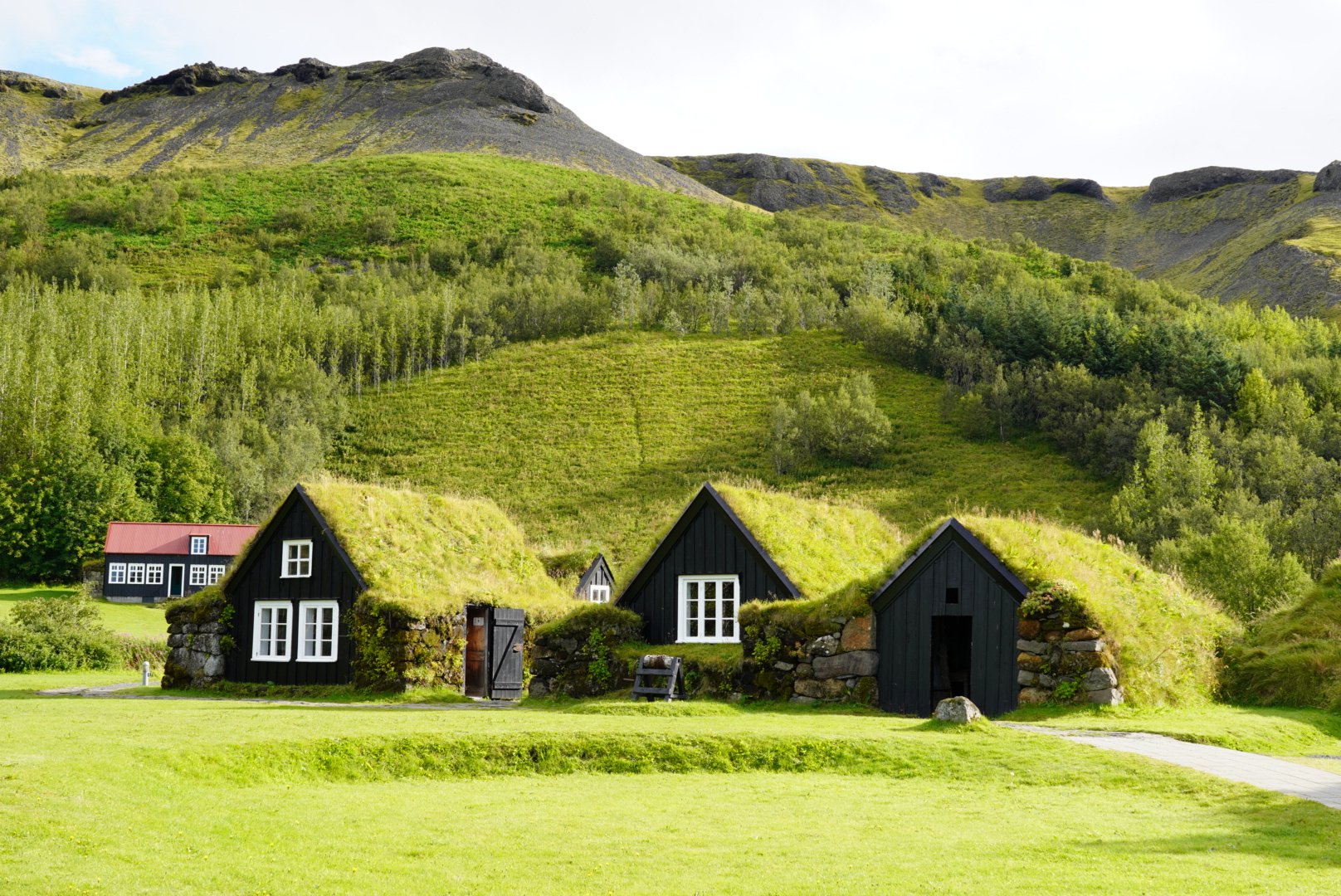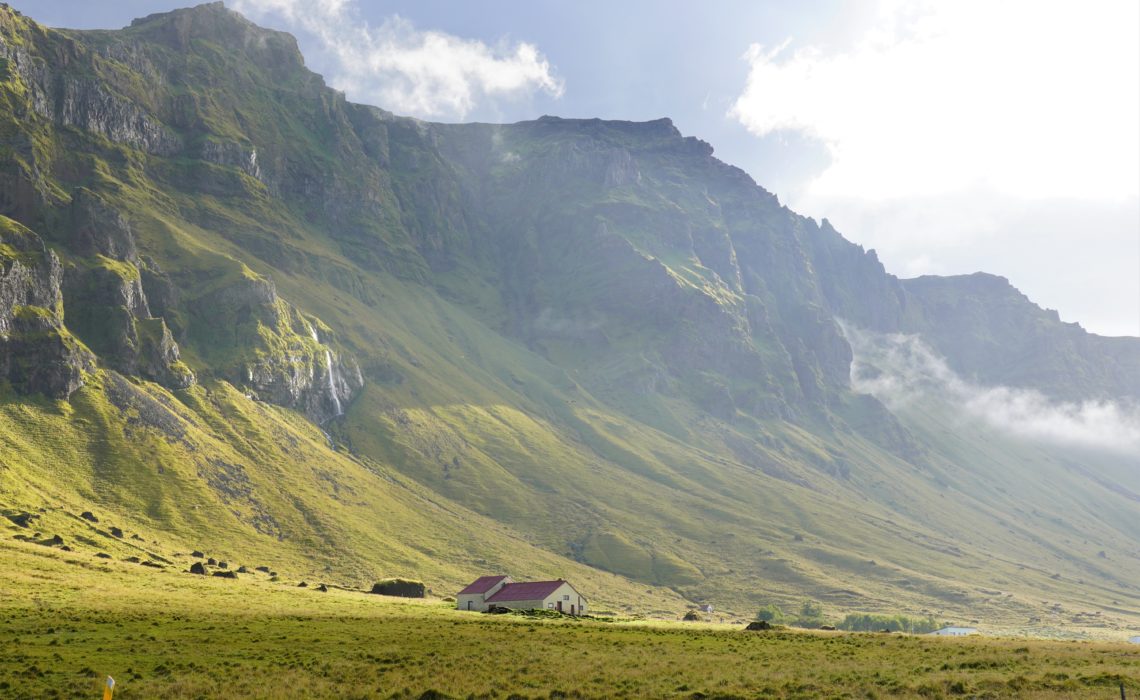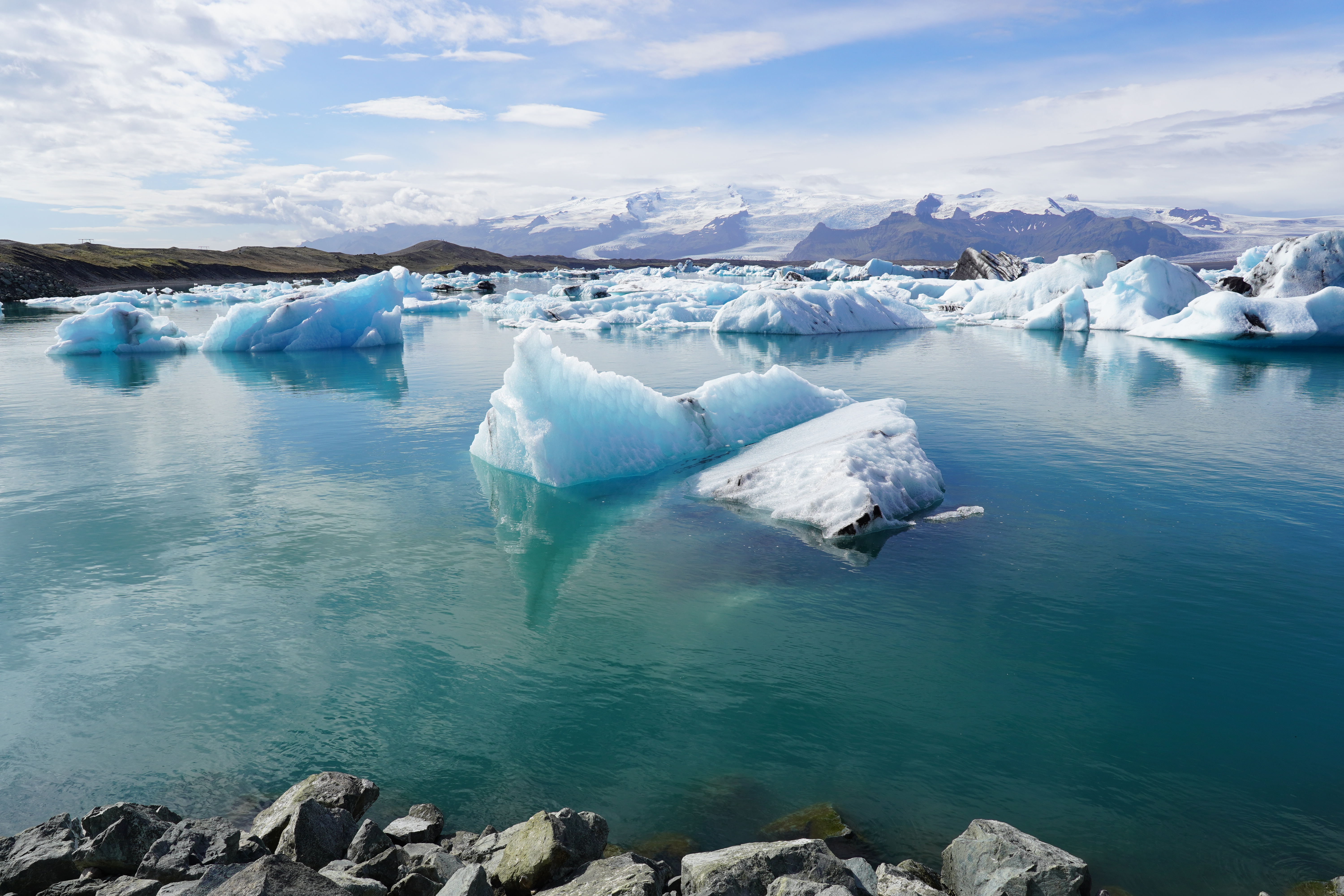We visited Iceland in the summer; a trip driven mostly by my sister’s desire to celebrate her birthday there. We flew from London UK to Keflavík International Airport. After a four-hour flight delay (not surprising, nonetheless), we arrived in Iceland with just enough time to drop off our luggage at our hotel in Reykjavik and head to our first stop: the Blue Lagoon.
Lava Restaurant
We first stopped by the Lava Restaurant for a family dinner to toast my little sister. This was our first exposure to Icelandic flavours. We savored cauliflower soup, lamb fillet, and cod – simple yet delicious dishes made with fresh local ingredients – accompanied by local beers and cocktails. Seated at a table by the glass windows, we were mesmerized by the endless blue of the lagoon, magnified by the way silica, the lagoon’s iconic element, reflects visible light when suspended in water.
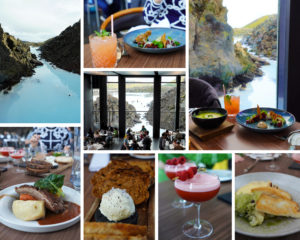
Blue Lagoon
After a quick shower, we headed to the lagoon. While in mid-August, the weather was clear and sunny, yet a bit chilly. The warm water, in contrast, glowing under the sun made the experience even more mystical. We enjoyed another drink while floating around the lagoon, trying to discover hidden spots. The silica mask we were offered to try for free made my face glow for days to come. We stayed until sunset witnessing the golden hills surrounding the steamy lagoon, making you question whether this was all a dream.

We headed back to Reykjavik. Having booked accommodation at Ekra Apartments, a couple of minutes from the downtown core and at the intersection with one of the busiest streets, made it irresistible to go out to explore Reykjavik nightlife despite the accumulated fatigue of a long day.
Fagradalsfjall Volcano
A couple of weeks prior to our arrival in Iceland, the Fagradalsfjall eruption, located on Reykjanes Peninsula in the southwest of Iceland, resumed activity after almost a year of inactivity. The eruption site was in the Meradalir Valley, around 60 km away from Reykjavík. As there were no direct roads to the eruption site, we drove for about an hour and parked at one of the designated parking areas.
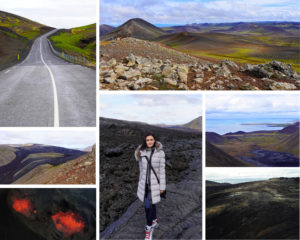
Fagradalsfjall means beautiful valley mountain. Indeed, the path we traversed took us through colourful hills surrounding a valley splashed with cold magma from the previous eruption and the North Atlantic Ocean in the background. We hiked for about 2.5 hours to reach the observation point on one of the highest hills closer to the active volcano. We could have reached the observation point earlier, but we couldn’t resist stopping frequently to admire the scenery and glimpse the lava.
Kirkjufell
After a quick stop at Búðakirkja, a small wooden black church located on the south side of Snæfellsnes Peninsula, we continued our journey northward and arrived at Kirkjufell, one of the most photographed mountains in Iceland. Kirkjufell takes its name ‘Church Mountain’ from its distinctly shaped peak resembling a church steeple, sharpened at the top with long curved sides. The best part about vising Iceland in August is the vibrant green Icelandic moss that frames the numerous waterfalls in the area, which this location also features.
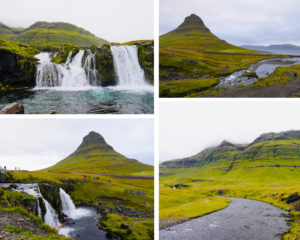
Skógafoss Waterfall
On our third day in Iceland, the weather was ideal to further explore South Iceland. After an early rise and a quick stop at Braud & Co for coffee and pastries, we selected Diamond Beach as our ultimate destination for the day, which was about 5 hours from Reykjavik, or 5 hours without any stops, I should say. Naturally, we deviated from our original plan, and gave into the temptation to make numerous stops on our way to see planned and unplanned gems.
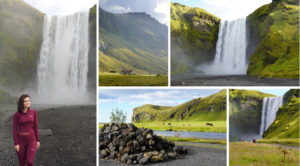
Our first stop was Skogafoss. We arrived there around 8 am, minutes before guided tour buses flooded the surrounding area, to admire this majestic waterfall undistracted. This waterfall is located on the Skóga River in the south of Iceland at the cliffs that were once the coastline and comes directly from two glaciers, Eyjafjallajokull and Myrdalsjokull.
Skógar Museum
Our next quick stop was at the Skógar Museum and Turf House, in Safnavegur, a few minutes away from Skógafoss. The museum has an eclectic cultural heritage collection of 18,000 regional folk craft artifacts exhibited in 3 museums and 6 historical buildings, including an open-air museum that allows visitors to experience traditional Icelandic architecture heritage. Its Café is also absolutely gorgeous with mouth watering desserts.
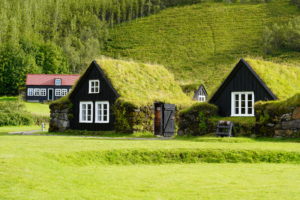
Stjórnarfoss Waterfall
We made an unplanned stop at the Stjórnarfoss waterfall, which is located just off the popular Ring Road. Far from the tourist gaze, we explored the hidden corners of the waterfall surrounded by a glowing green velvet carpet. With this natural beauty all to ourselves, we felt time slow down and found peace in the soothing sound of the waterfall.
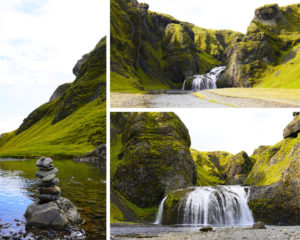
Jökulsárlón Glacier Lagoon
Iceland is notorious for its versatile landscapes, so it was not surprising to us to find ourselves from lush fields and hills to a polar scenery within the span of a few hours. Nevertheless, the sight was awe-inspiring. The unique blue of the lagoon is owed to the fact that it is composed of seawater and freshwater since the lagoon connects with the ocean. The scenery continued to change as icebergs, composed of ice that is over 1,000 years old, gracefully danced their way toward the ocean.
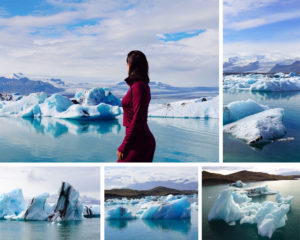
Diamond Beach
A few minutes south of the Jökulsárlón Glacier Lagoon lies the Diamond Beach, where icebergs that fill the lagoon wash up on shore, creating a striking contrast with the volcanic black sand. If you pay attention, you will see that the colours of the ice may slightly differ. The bluer the ice the older it is since the colour can signify age and the lack of air pockets. The black colouring, on the other hand, can be volcanic dust.
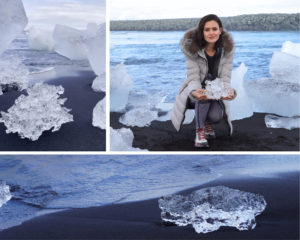
Reynisfjara
Heading back to Reykjavik, about two-and-a-half-hour drive away, we stopped at Reynisfjara, also known as the Black Sand Beach, boasts of dramatic Reynisdrangar basalt cliffs and geometric columns. These rock formations were created through a process called columnar jointing, where fast-flowing lava from a nearby volcano cooled and gave birth to these columnar stacks. Although we were not lucky enough to see them, between May and August each year, these cliffs are the nesting site for puffins.
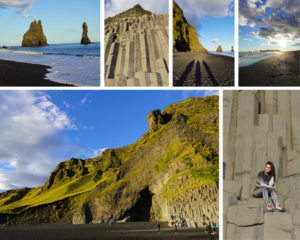
Reynisfjara is on the South Coast of Iceland, just off of the famous ring road. It’s important to note that the waves at Reynisfjara Beach can be dangerous and visitors should avoid turning their back to them. Sneaker waves, which come in unexpectedly, have been the cause of more than one fatality. Additionally, Reynisfjara’s rip currents can drag people under the freezing waters in the blink of an eye. A safe distance from the shore is best to be maintained at all times.
Seljalandsfoss
Sunset found us at the Seljalandsfoss waterfall, which, unlike most other waterfalls in Iceland, it makes it possible for you to walk behind it and enjoy the surrounding view that stretches to the coastline. Seljalandsfoss is part of the river Seljalandsá, has its origins underneath the glacier Eyjafjallajökull. The lineup was long and no one was in the mood to get wet while waiting in the line, so we decided to enjoy the view of the waterfall framed by pink clouds from the comfort of our car while listening to KALEO’s Vor í Vaglaskógi song.
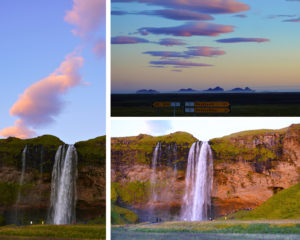
Reykjavik
We spent our lazy Sunday exploring Reykjavik before heading to North Iceland. Our hotel was a few meters away from the famous Rainbow Street, Skólavörðustígur. We passed by the old prison located on Skólavörðurstígur 9, which operated for 144 years and now houses an art exhibition called “Ljós í steini” featuring 24 portraits of men who were arrested and confined in the prison.
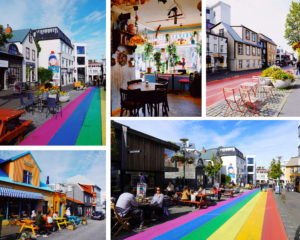
After a quick stop at Café Babalú for coffee and light bites, the road led us to the Hallgrimskirkja Church, one of the city’s best-known landmarks. We could not enter because of the Sunday mass, so we kept on strolling around the city. In front of the church lies the sculpture of Leifur Eiriksson, who is the first known European to have set foot on the North American continent before Christopher Columbus. The statute was a gift from the United States to commemorate the 1000-year anniversary of Althingi, the supreme national parliament of Iceland and the oldest parliament in the world, established in 930 AD.
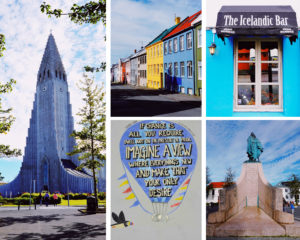
Around the statue, there was an outdoor art installation called “ARMORS” by Icelandic sculptor Steinunn Thorarinsdottir, who is known for the figures of androgynous folks she has placed at iconic landmarks across the globe. The installation features three pairs of statues, with each pair having a knight facing one of Thorarinsdottir’s nude figures, aiming to merge medieval armors and ageless, androgynous figures in a way that would speak to the human condition today and in the past.
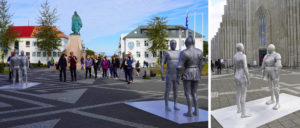
While shopping is not a priority to me when I travel, I could not resist visiting the Blue Lagoon Store in Reykjavik and sampling the different products guided by an extremely helpful and generous sales associate. Still impressed by how my face kept glowing days after our visit to the Blue Lagoon, I decided to treat myself silica and algae masks in an attempt to prolong the Icelandic experience.

We could not leave Reykjavik without a last stop at Íslenski Barinn, an authentic Icelandic restaurant, whose menu follows the same creed, with Icelandic ingredients and techniques. We tried the soup of the day and reindeer burgers while plotting our next adventures.

Strokkur, Hafnartún, Selfoss
We left Reykjavik en route to North Iceland, and our first stop was Strokkur, a fountain-type geyser located in a geothermal area beside the Hvítá River. The geyser typically erupts every 6–10 minutes, reaching up to 40-meter heights. A few meters from Strokkur lies Geysir, also known as the Great Geysir, which is much larger, but currently in an inactive phase. Although it has been dormant since 2005, when it does erupt, the water can shoot up in the air as high as 70 metres.
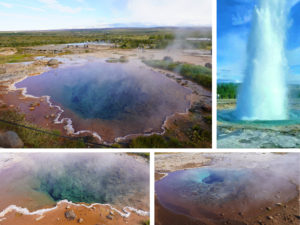
The area also features many fumaroles, hot springs, and other little geysers. My favourite was Blesi, a beautiful set of twin pools located up a small hill behind Geysir. One has a deep blue color, similar to the Blue Lagoon, created by colloidal silica, and the other has a clear green to turquoise colour allowing a clear view of the hole from which the boiling hot water originates.
The Kjölur Route
Heading north, we decided to take the F35 road. F roads, that is, mountain roads, are unpaved and require a 4×4 vehicle. F35 is the second-longest Icelandic F-road and one of the only two roads which connect the southern and the northern Iceland directly. The views resembled a Martian rocky landscape often painted in a deep red colour in contrast with the Langjökull glacier that framed the horizon.
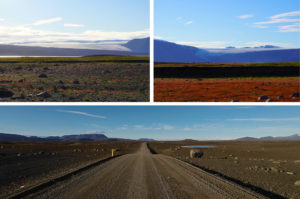
Hveravellir
Around sunset, we reached Hveravellir, a geothermal hot spring with smoking fumaroles and bubbling water holes, located between the Langjökull and Hofsjökull glaciers. The hot springs are surrounded by white, yellow, emerald, and purple circles, which create distinct wavy patterns. In addition to the hot springs, the location features a lodge as well as the oldest still standing turf rest house at Hveravellir, built in 1922.

Hveravellir was a destination famously used by exiled criminals. One of them, Fjalla-Eyvindur, that is, Eyvindur of the Mountains, was reported to have fled there with his wife after 1760, living in the wildness for 20 years A hot spring named Eyvindarhver is named after him.
Back to Reykjavik
After about three days in North Iceland, we returned to Reykjavik, only to realize that we had not booked a hotel. The situation looked a lot like the Friends episode where Monica and Rachel were locked outside the apartment debating whether “got the keys” (or “booked the hotel” in our case) was a statement or a question. To our surprise, booking last minute did not cost us a fortune. We ended up benefiting from last-minute deals on booking.com and booked a room at a gorgeous hotel, R13 – A Townhouse Hotel. The décor of our room resembled the inside of a train cabin albeit much more spacious.
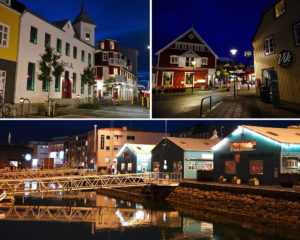
Ready to enjoy our last night in Reykjavik, we realized that the downtown area was blocked and no cars were allowed before midnight because the locals were celebrating… Culture Night! The endless fireworks and the limited access to the city core sounded too intriguing, but we soon witnessed anything but culture; it was mostly an excuse for teenagers (or what looked as such) to drink too much… with everything that follows that. I may have appreciated this more if I happened to be there a decade ago! We spent our last night grabbing a last-minute bite at one of the two street food establishments located at the city center since all restaurants were closed by that time. We ended the night at a pub with live music and singing alongside locals.
Hvalfjörður Fjord
On our final day in Iceland, we took a scenic ride through Hvalfjörður fjord, which translates to “Whale Fjord”. The area is rich in bird life and is home to seals. Historically, Hvalfjörður was one of the most significant naval stations in the North Atlantic during World War II, when Iceland was occupied by the Allies after the Nazis conquered Denmark.

Before heading to the airport, we took a final stroll around the downtown core of Reykjavik. We even made it to the top of Hallgrimskirkja Church, to enjoy the panoramic view of the city. Finally, we stopped outside Harpa Concert Hall, which won the European Union’s Mies van der Rohe award for contemporary architecture in 2013.
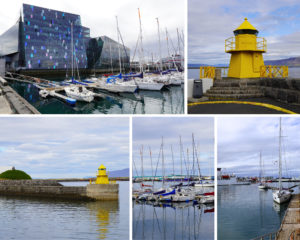
As this trip came to an end, I was left in awe of the country’s stark contrasts. From witnessing the raw power of lava flows and the spectacle of an active volcano to exploring the frozen beauty of glaciers, I had been constantly reminded of the dynamic nature of this land of fire and ice. From the rugged landscapes of the highlands to the quaint fishing villages along the coast, I feel lucky to have explored some of endless opportunities for adventure and discovery Iceland offers.


